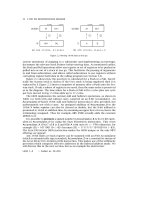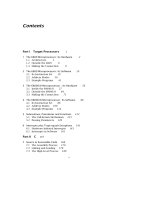Tài liệu Praise for The Art of Agile Development ppt
Bạn đang xem bản rút gọn của tài liệu. Xem và tải ngay bản đầy đủ của tài liệu tại đây (9.05 MB, 432 trang )
www.it-ebooks.info
Praise for The Art of Agile Development
“Jim Shore and Shane Warden expertly explain the practices and benefits of Extreme
Programming. They offer advice from their real-world experiences in leading teams.
They answer questions about the practices and show contraindications—ways that a
practice may be misapplied. They offer alternatives you can try if there are impediments
to applying a practice, such as the lack of an on-site customer.
“The explanations do not stop with just the practices. Discussion of people-related issues,
such as strategies for creating trust and team cohesiveness, rounds out the book.”
— Ken Pugh, author of the Jolt-Award-winning book, Prefactoring
“I will leave a copy of this book with every team I visit.”
— Brian Marick, Exampler Consulting
endorsements Page i Thursday, October 11, 2007 10:37 PM
www.it-ebooks.info
endorsements Page ii Thursday, October 11, 2007 10:37 PM
www.it-ebooks.info
The Art of Agile Development
www.it-ebooks.info
Other resources from O’Reilly
Related titles
Beautiful Code
Extreme Programming Pocket
Guide
Prefactoring
Applied Software Project
Management
oreilly.com
oreilly.com is more than a complete catalog of O’Reilly books.
You’ll also find links to news, events, articles, weblogs, sample
chapters, and code examples.
oreillynet.com is the essential portal for developers interested in
open and emerging technologies, including new platforms, pro-
gramming languages, and operating systems.
Conferences
O’Reilly brings diverse innovators together to nurture the ideas
that spark revolutionary industries. We specialize in document-
ing the latest tools and systems, translating the innovator’s
knowledge into useful skills for those in the trenches. Visit con-
ferences.oreilly.com for our upcoming events.
Safari Bookshelf (safari.oreilly.com) is the premier online refer-
ence library for programmers and IT professionals. Conduct
searches across more than 1,000 books. Subscribers can zero in
on answers to time-critical questions in a matter of seconds.
Read the books on your Bookshelf from cover to cover or sim-
ply flip to the page you need. Try it today for free.
www.it-ebooks.info
The Art of Agile Development
James Shore and Shane Warden
Beijing
•
Cambridge
•
Farnham
•
Köln
•
Paris
•
Sebastopol
•
Taipei
•
Tokyo
www.it-ebooks.info
The Art of Agile Development
by James Shore and Shane Warden
Copyright © 2008 O’Reilly Media, Inc., Inc. All rights reserved.
Printed in the United States of America.
Published by O’Reilly Media, Inc., 1005 Gravenstein Highway North, Sebastopol, CA 95472
O’Reilly books may be purchased for educational, business, or sales promotional use. Online editions are
also available for most titles (). For more information, contact our corporate/
institutional sales department: (800) 998-9938 or
Editor: Mary O’Brien
Copy Editor: Sarah Schneider
Production Editor: Sarah Schneider
Proofreader: Sada Preisch
Indexer: Joe Wizda
Cover Designer: Karen Montgomery
Interior Designer: David Futato
Illustrator: Robert Romano
Printing History:
October 2007: First Edition.
The O’Reilly logo is a registered trademark of O’Reilly Media, Inc. The Theory in Practice series designations,
The Art of Agile Development, and related trade dress are trademarks of O’Reilly Media, Inc.
While every precaution has been taken in the preparation of this book, the publisher and authors assume
no responsibility for errors or omissions, or for damages resulting from the use of the information contained
herein.
TM
This book uses RepKover™, a durable and flexible lay-flat binding.
ISBN-10: 0-596-52767-5
ISBN-13: 978-0-596-52767-9
[C]
www.it-ebooks.info
To our families.
www.it-ebooks.info
www.it-ebooks.info
Table of Contents
Preface . . . . . . . . . . . . . . . . . . . . . . . . . . . . . . . . . . . . . . . . . . . . . . . . . . . . . . . . . . . . . . . . xiii
Part I. Getting Started
1. Why Agile? . . . . . . . . . . . . . . . . . . . . . . . . . . . . . . . . . . . . . . . . . . . . . . . . . . . . . . . . . . 3
Understanding Success 4
Beyond Deadlines 4
The Importance of Organizational Success 5
Enter Agility 6
2. How to Be Agile . . . . . . . . . . . . . . . . . . . . . . . . . . . . . . . . . . . . . . . . . . . . . . . . . . . . . 9
Agile Methods 9
Don’t Make Your Own Method 10
The Road to Mastery 11
Find a Mentor 12
3. Understanding XP . . . . . . . . . . . . . . . . . . . . . . . . . . . . . . . . . . . . . . . . . . . . . . . . . 15
The XP Lifecycle 18
The XP Team 27
XP Concepts 39
4. Adopting XP . . . . . . . . . . . . . . . . . . . . . . . . . . . . . . . . . . . . . . . . . . . . . . . . . . . . . . . 43
Is XP Right for Us? 43
Go! 51
Assess Your Agility 62
Part II. Practicing XP
5. Thinking . . . . . . . . . . . . . . . . . . . . . . . . . . . . . . . . . . . . . . . . . . . . . . . . . . . . . . . . . . . 69
Pair Programming 71
Energized Work 79
Informative Workspace 83
IX
www.it-ebooks.info
Root-Cause Analysis 88
Retrospectives 91
6. Collaborating . . . . . . . . . . . . . . . . . . . . . . . . . . . . . . . . . . . . . . . . . . . . . . . . . . . . . . 99
Trust 102
Sit Together 112
Real Customer Involvement 120
Ubiquitous Language 124
Stand-Up Meetings 129
Coding Standards 133
Iteration Demo 138
Reporting 144
7. Releasing . . . . . . . . . . . . . . . . . . . . . . . . . . . . . . . . . . . . . . . . . . . . . . . . . . . . . . . . 153
“Done Done” 156
No Bugs 160
Version Control 169
Ten-Minute Build 177
Continuous Integration 183
Collective Code Ownership 191
Documentation 195
8. Planning . . . . . . . . . . . . . . . . . . . . . . . . . . . . . . . . . . . . . . . . . . . . . . . . . . . . . . . . . . 199
Vision 201
Release Planning 206
The Planning Game 219
Risk Management 224
Iteration Planning 233
Slack 246
Stories 253
Estimating 260
9. Developing . . . . . . . . . . . . . . . . . . . . . . . . . . . . . . . . . . . . . . . . . . . . . . . . . . . . . . . 271
Incremental Requirements 273
Customer Tests 278
Test-Driven Development 285
Refactoring 303
Simple Design 314
Incremental Design and Architecture 321
Spike Solutions 331
Performance Optimization 335
Exploratory Testing 341
X T AB LE O F CO NT EN TS
www.it-ebooks.info
Part III. Mastering Agility
10. Values and Principles . . . . . . . . . . . . . . . . . . . . . . . . . . . . . . . . . . . . . . . . . . . . . 353
Commonalities 353
About Values, Principles, and Practices 354
Further Reading 354
11. Improve the Process . . . . . . . . . . . . . . . . . . . . . . . . . . . . . . . . . . . . . . . . . . . . . . 357
Understand Your Project 357
Tune and Adapt 358
Break the Rules 359
12. Rely on People . . . . . . . . . . . . . . . . . . . . . . . . . . . . . . . . . . . . . . . . . . . . . . . . . . . 361
Build Effective Relationships 361
Let the Right People Do the Right Things 363
Build the Process for the People 364
13. Eliminate Waste . . . . . . . . . . . . . . . . . . . . . . . . . . . . . . . . . . . . . . . . . . . . . . . . . . 367
Work in Small, Reversible Steps 367
Fail Fast 369
Maximize Work Not Done 370
Pursue Throughput 371
14. Deliver Value . . . . . . . . . . . . . . . . . . . . . . . . . . . . . . . . . . . . . . . . . . . . . . . . . . . . . 375
Exploit Your Agility 375
Only Releasable Code Has Value 376
Deliver Business Results 378
Deliver Frequently 379
15. Seek Technical Excellence . . . . . . . . . . . . . . . . . . . . . . . . . . . . . . . . . . . . . . . . 381
Software Doesn’t Exist 381
Design Is for Understanding 382
Design Trade-offs 383
Quality with a Name 383
Great Design 383
Universal Design Principles 384
Principles in Practice 387
Pursue Mastery 388
References . . . . . . . . . . . . . . . . . . . . . . . . . . . . . . . . . . . . . . . . . . . . . . . . . . . . . . . . . . . 391
Index . . . . . . . . . . . . . . . . . . . . . . . . . . . . . . . . . . . . . . . . . . . . . . . . . . . . . . . . . . . . . . . . . 397
T AB LE O F CO NT EN TS XI
www.it-ebooks.info
www.it-ebooks.info
Preface
Q: How do you get to Carnegie Hall?
A: Practice, man, practice!
We want to help you master the art of agile development.
Agile development, like any approach to team-based software development, is a fundamentally
human art, one subject to the vagaries of individuals and their interactions. To master agile development,
you must learn to evaluate myriad possibilities, moment to moment, and intuitively pick the best course
of action.
How can you possibly learn such a difficult skill? Practice!
First and foremost, this book is a detailed description of one way to practice agile development: Extreme
Programming (XP). It’s a practical guide that, if followed mindfully, will allow you to successfully bring
agile development in the form of XP to your team—or will help you decide that it’s not a good choice
in your situation.
Our second purpose is to help you master the art of agile development. Mastering agility means going
beyond our cookbook of practices. Agile development is too context-sensitive for one approach to be
entirely appropriate, and too nuanced for any book to teach you how to master it. Mastery comes from
within: from experience and from an intuitive understanding of ripples caused by the pebble of a choice.
We can’t teach you how your choices will ripple throughout your organization. We don’t try. You must
provide the nuance and understanding. This is the only way to master the art. Follow the practices.
Watch what happens. Think about why they worked or didn’t work. Then do them again. What was
the same? What was different? Why? Then do it again. And again.
At first, you may struggle to understand how to do each practice. They may look easy on paper, but
putting some practices into action may be difficult. Keep practicing until they’re easy.
As XP gets easier, you will discover that some of our rules don’t work for you. In the beginning, you
won’t be able to tell if the problem is in our rules or in the way you’re following them. Keep practicing
until you’re certain. When you are, break the rules. Modify our guidance to work better for your specific
situation.
Parts I and II of this book contain our approach to XP. Part I helps you get started with Extreme
Programming; Part II provides detailed guidance for each of XP’s practices. Parts I and II should keep
you occupied for many months.
XIII
www.it-ebooks.info
When you’re ready to break the rules, turn to Part III. A word of warning: there is nothing in Part III
that will help you practice XP. Instead, it’s full of ideas that will help you understand XP and agile
development more deeply.
One day you’ll discover that rules no longer hold any interest for you. After all, XP and agile
development aren’t about following rules. “It’s about simplicity and feedback, communication and
trust,” you’ll think. “It’s about delivering value—and having the courage to do the right thing at the
right time.” You’ll evaluate myriad possibilities, moment to moment, and intuitively pick the best course
of action.
When you do, pass this book on to someone else, dog-eared and ragged though it may be, so that they
too can master the art of agile development.
For the Pragmatists
What if you don’t want to master a so-called art? What if you just want to develop good software?
Don’t worry—this book is for you, too. Parts I and II are just what you need. We took our years of
experience with agile development and Extreme Programming and distilled them into a single, clearly
defined, comprehensive approach.
This approach allows us to use plain, straightforward language without caveats or digressions. We get
to include a lot of practical tips. We candidly describe when our approach won’t work and what
alternatives to consider when it doesn’t.
There’s a downside to discussing just one approach: no single methodology is appropriate for everyone.
Our advice may not be appropriate for your team or situation. Be sure to read Chapter 4 before putting
our advice into practice.
You may be able to adopt part of XP even if you can’t adopt all of it. The “Contraindications” section of
each practice in Part II describes when a practice is inappropriate. If this applies to your situation, the
“Alternatives” section will help you decide what to do instead.
Don’t go too far and automatically assume that a particular practice won’t work for you. Some of the
ideas in this book are counterintuitive or just don’t sound like fun. Most of them work best in concert
with the others. If you can, try the practices as written for a few months, gain some real-world
experience on how they work in your environment, and then change them.
We’ve been putting these ideas into practice for years. In the right environment, they really work. Agile
development has been more fun, and more successful, than any other approach to team software
development we’ve tried. Come join the ride.
Who Should Read This Book
This book is for anyone who is, will be, or wants to be part of an agile team. That includes programmers,
of course, but it also includes domain experts, testers, projects managers, architects, designers, and
business analysts. Agile teams are cross-functional; this book reflects that fact.
If you’re a leader or you’re interested in bringing agile development to your team or organization, you
should read the whole book from cover to cover. Part I introduces agile concepts and describes how to
adopt XP. Part II describes each of XP’s practices in detail. Part III goes beyond XP, looking at the
principles that allow you to create your own agile method by customizing XP to your particular situation.
XIV P RE FA CE
www.it-ebooks.info
If you just want to learn enough to do your job, you can focus primarily on Part II. Start with
Chapter 3 in Part I to get an overview, then read through the practices in Part II that apply to your work.
Each practice starts with a description of the audience it applies to, such as “Programmers,” “Customers,”
or “Testers.”
If you’re merely curious about agile development, start by reading Part I. Again, Chapter 3 provides a
good introduction. Afterwards, take a look at the practices in Part II. Start with the ones that look most
interesting; you can read them in any order.
About the Études
Have you ever heard a musician playing scales? That’s an étude (if a boring one). An étude teaches
mastery through precise and careful repetition. Eventually, the étude is abandoned, but the skills
remain.
Extreme Programming is our étude for software development. We hope that practicing Extreme
Programming week after week will help you master agile development. Eventually, you’ll change your
practices, but the underlying principles will remain.
Besides the overarching étude of Extreme Programming, we’ve included a mini-étude for each major
theme of agile development. Beginning agile teams can use the études to refine their practice of agile
development. As you gain experience, look deeper; use the études to help connect Part II’s detailed
practices to Part III’s general principles.
NOTE
These études are also useful for teams not currently practicing XP.
Either way, the études require thought to be effective. Each étude provides information, but it doesn’t
tell you how to act on that information. Think about it. What did you learn from the étude? What was
frustrating or exciting? How does that information affect your work? What will you do about it? Without
attention and reflection—that is, mindfulness—the études are just games.
NOTE
It’s no coincidence that you need mindfulness to master the art of agile development
as well. You have to think about more than XP’s practices for it to be effective.
Like musical études, our mini-études work best when you repeat them. We’ve designed them to take
half an hour, so you can (and should) practice them every day for a week or more. Unlike musical
études, these agile exercises work best when you include your whole team. The more you all understand
about the process and where everyone fits in, the better you will work together.
To start, you need a quiet work area capable of holding everyone in your team comfortably. There
should be a whiteboard or wall where you can hang or post index cards between meetings. There must
also be sufficient space to break into groups of two or three people and to talk softly without disturbing
other groups.
We’ve found it valuable to use a timer, whether a stopwatch or a kitchen timer, to keep the session
moving. Each étude has a few parts of 5 to 10 minutes. Although that time will seem to flow quickly
P RE FA CE XV
www.it-ebooks.info
on your first day, respect the time limits. You’ll perform the étude again tomorrow, so it’s OK if you
don’t finish everything.
Choose one member of your team to facilitate the étude by watching the time (perhaps calling out “one
minute remaining” when appropriate) and promoting discussion. Again, the first session may be hard,
but a good facilitator can encourage everyone to continue.
At the end of each étude, we recommend spending a few minutes debriefing. What did you learn? Are
there questions and ideas you can follow up on during your regular work? If you’ve been trying this
exercise for more than a week, are you still getting valuable results?
If you’re new to XP and agile development, we strongly recommend that you perform each étude while
you study the related chapter as a team. Besides exploring one particular theme in agile development,
each étude can illuminate an aspect of how your team works together on your agile project.
About Pronouns
We speak in first-person singular rather than first-person plural in the rest of this book. (We say “I,”
not “we.”) We include a lot of personal anecdotes and experiences, and the singular form works better
as a result. However, this book is unquestionably the result of a partnership between two authors and
our use of the word “I” is merely a convenience.
Using Code Examples
This book is here to help you get your job done. In general, you may use the code in this book in your
programs and documentation. You do not need to contact us for permission unless you’re reproducing
a significant portion of the code. For example, writing a program that uses several chunks of code from
this book does not require permission. Selling or distributing a CD-ROM of examples from O’Reilly
books does require permission. Answering a question by citing this book and quoting example code
does not require permission. Incorporating a significant amount of example code from this book into
your product’s documentation does require permission.
We appreciate, but do not require, attribution. An attribution usually includes the title, author,
publisher, and ISBN. For example: “The Art of Agile Development by James Shore and Shane Warden.
Copyright 2008 O’Reilly Media, Inc., 978-0-596-52767-9.”
If you feel your use of code examples falls outside fair use or the permission given above, feel free to
contact us at
Safari® Enabled
When you see a Safari® Enabled icon on the cover of your favorite technology book, that means the
book is available online through the O’Reilly Network Safari Bookshelf.
Safari offers a solution that’s better than e-books. It’s a virtual library that lets you easily search
thousands of top tech books, cut and paste code samples, download chapters, and find quick answers
when you need the most accurate, current information. Try it for free at .
XVI P RE FA CE
www.it-ebooks.info
How to Contact Us
Please address comments and questions concerning this book to the publisher:
O’Reilly Media, Inc.
1005 Gravenstein Highway North
Sebastopol, CA 95472
800-998-9938 (in the United States or Canada)
707-829-0515 (international or local)
707 829-0104 (fax)
We have a web page for this book, where we list errata, examples, and any additional information. You
can access this page at:
/>To comment or ask technical questions about this book, send email to:
For more information about our books, conferences, Resource Centers, and the O’Reilly Network, see
our web site at:
Acknowledgments
We owe a debt of gratitude to Elisabeth Hendrickson for her contribution of the “Exploratory Testing”
section. Her expertise and writing skill made the material sparkle. For more of Elisabeth’s writing, visit
/>We stole good ideas wherever we could find them. Kent Beck, Ron Jeffries, and Ward Cunningham
each had a hand in the ideas that led to XP, and we stole liberally from those. In addition to XP itself,
Kent Beck introduced us to the idea of XP practices as études. Ward Cunningham introduced us to the
notion of technical debt, a concept we use heavily. Brian Marick’s series of essays, “Agile Testing
Directions,”
*
influenced our thoughts on agile testing and the role of testers on agile teams.
James had the opportunity to work with Joshua Kerievsky on an Industrial XP (IXP)
†
project for half a
year. He learned a lot from that project; the Vision practice in particular was inspired by IXP’s Project
Chartering practice. David Schwartz and Amy Schwab of True North pgs, Inc.,
‡
provided the specific
vision format that we use, as well as the term project community. Their Mastering Projects workshop is
excellent; take it when you have the opportunity.
Thank you to our editor, Mary Treseler O’Brien, for providing vision (where necessary), trust (where
appropriate), and deadlines (where frightening). This book would not be what it is without you gently
nudging us in directions different from our original ideas.
Thanks also to our army of reviewers, who provided over one thousand comments and suggestions on
our mailing list. In particular, thanks to Adrian Howard, Adrian Sutton, Ann Barcomb, Andy Lester,
*
/>†
/>‡
/>P RE FA CE XVII
www.it-ebooks.info
Anthony Williams, Bas Vodde, Bill Caputo, Bob Corrick, Brad Appleton, Chris Wheeler, Clarke Ching,
Daði Ingólfsson, Diana Larsen, Erik Petersen, George Dinwiddie, Ilja Preuß, Jason Yip, Jeff Olfert, Jeffery
Palermo, Jonathan Clarke, Keith Ray, Kevin Rutherford, Kim Gräsman, Lisa Crispin, Mark Waite,
Nicholas Evans, Philippe Antras, Randy Coulman, Robert Schmitt, Ron Jeffries, Shane Duan, Tim
Haughton, and Tony Byrne for their extensive comments. Special thanks to Brian Marick, Ken Pugh,
and Mark Streibeck for their comments on the completed draft.
James Shore
Every work builds on what came before. I was fortunate to have not just one, but many giants to stand
on. Without the inspired work of Kent Beck, Alistair Cockburn,Ward Cunningham, Tom DeMarco,
Martin Fowler, Ron Jeffries, Timothy Lister, Steve McConnell, and Gerald Weinberg, I wouldn’t have
anything close to the understanding of software development I have today. It’s thanks to their example
that this book exists. In particular, thanks to Alistair Cockburn for generously inviting me to his
roundtable and introducing me to the agile community.
If giants enabled me to contribute to this book, then Kim Eaves and the Denali team brought the
stepladder. Without their enthusiastic support, I never would have been able to try that crazy XP thing.
Thanks also to Rob Myers for his ever-friendly consideration of my rants.
I also gratefully acknowledge my coauthor and friend, Shane Warden. This project morphed from a
little 100-page second edition into a 400-page monster. You didn’t complain once. Thanks for putting
up with me. (And hey! Nice book.)
Finally, thank you, Neeru, my loving and patient wife. I used to think authors thanking their families
was cliché. Now I understand. I couldn’t have finished this book without your support.
Shane Warden
Thanks to Jim for arguing with me while writing the first version of this book (it’s better for it) and for
convincing me that the second edition was worth doing.
Thanks to Allison and Andrew for the tools we used to write this book.
Thanks to my family for supporting me (and not grumbling too much while I sat upstairs and wrote
very slowly), and to my friends for dragging me out of my house once in a while.
Thanks also to the other contributors to Parrot and Perl 6 for being unwitting collaborators, examples,
and victims of some of the ideas in this book. The work we do continually amazes me.
XVIII P RE FA CE
www.it-ebooks.info
PART I
Getting Started
www.it-ebooks.info
www.it-ebooks.info
CHAPTER 1
Why Agile?
Agile development is popular. All the cool kids are doing it: Google, Yahoo, Symantec, Microsoft, and
the list goes on.
*
I know of one company that has already changed its name to Agili-something in order
to ride the bandwagon. (They called me in to pitch their “agile process,” which, upon further inspection,
was nothing more than outsourced offshore development, done in a different country than usual.) I
fully expect the big consulting companies to start offering Certified Agile Processes and Certified Agile
Consultants—for astronomical fees, of course—any day now.
Please don’t get sucked into that mess.
In 1986, [Brooks] famously predicted that there were no silver bullets: that by 1996, no single
technology or management technique would offer a tenfold increase in productivity, reliability, or
simplicity. None did.
Agile development isn’t a silver bullet, either.
In fact, I don’t recommend adopting agile development solely to increase productivity. Its benefits—
even the ability to release software more frequently—come from working differently, not from working
faster. Although anecdotal evidence indicates that agile teams have above-average productivity,
†
that
shouldn’t be your primary motivation. Your team will need time to learn agile development. While they
learn—and it will take a quarter or two—they’ll go slower, not faster. In addition, emphasizing
productivity might encourage your team to take shortcuts and to be less rigorous in their work, which
could actually harm productivity.
Agile development may be the cool thing to do right now, but that’s no reason to use it. When you
consider using agile development, only one question matters.
Will agile development help us be more successful?
*
Source: various experience reports at the Extreme Programming and Agile conferences.
†
See, for example, [Van Schooenderwoert], [Mah], and [Anderson 2006].
3
www.it-ebooks.info
When you can answer that question, you’ll know whether agile development is right for you.
Understanding Success
The traditional idea of success is delivery on time, on budget, and according to specification. [Standish]
provides some classic definitions:
Successful
“Completed on time, on budget, with all features and
functions as originally specified.”
Challenged
“Completed and operational but over budget, over the
time estimate, [with] fewer features and functions than originally specified.”
Impaired
“Cancelled at some point during the development cycle.”
Despite their popularity, there’s something wrong with these definitions. A project can be successful
even if it never makes a dime. It can be challenged even if it delivers millions of dollars in revenue.
CIO Magazine commented on this oddity:
Projects that were found to meet all of the traditional criteria for success—time, budget and
specifications—may still be failures in the end because they fail to appeal to the intended users
or because they ultimately fail to add much value to the business.
Similarly, projects considered failures according to traditional IT metrics may wind up being
successes because despite cost, time or specification problems, the system is loved by its target
audience or provides unexpected value. For example, at a financial services company, a new
system was six months late and cost more than twice the original estimate (final cost was
$5.7 million). But the project ultimately created a more adaptive organization (after 13
months) and was judged to be a great success—the company had a $33 million reduction in
write-off accounts, and the reduced time-to-value and increased capacity resulted in a 50
percent increase in the number of concurrent collection strategy tests in production.
*
Beyond Deadlines
There has to be more to success than meeting deadlines but what?
When I was a kid, I was happy just to play around. I loved the challenge of programming. When I got
a program to work, it was a major victory. Back then, even a program that didn’t work was a success
of some sort, as long as I had fun writing it. My definition of success centered on personal rewards.
As I gained experience, my software became more complicated and I often lost track of how it worked.
I had to abandon some programs before they were finished. I began to believe that maintainability was
the key to success—an idea that was confirmed as I entered the workforce and began working with
teams of other programmers. I prided myself on producing elegant, maintainable code. Success meant
technical excellence.
Despite their popularity, there’s
something wrong with these
definitions.
*
R. Ryan Nelson, “Applied Insight—Tracks in the Snow,” CIO Magazine, />4 C HA PT ER 1 : WH Y A G I L E ?
www.it-ebooks.info
Despite good code, some projects flopped. Even impeccably executed projects could elicit yawns from
users. I came to realize that my project teams were part of a larger ecosystem involving dozens,
hundreds, or even thousands of people. My projects needed to satisfy those people particularly the
ones signing my paycheck. In fact, for the people funding the work, the value of the software had to
exceed its cost. Success meant delivering value to the organization.
These definitions aren’t incompatible. All three types of success are important (see Figure 1-1). Without
personal success, you’ll have trouble motivating yourself and employees. Without technical success,
your source code will eventually collapse under its own weight. Without organizational success, your
team may find that they’re no longer wanted in the company.
The Importance of Organizational Success
Organizational success is often neglected by software teams in favor of the more easily achieved technical
and personal successes. Rest assured, however, that even if you’re not taking responsibility for
organizational success, the broader organization is judging your team at this level. Senior
management and executives aren’t likely to care if your software is elegant, maintainable, or even
beloved by its users; they care about results. That’s their return on investment in your project. If you
don’t achieve this sort of success, they’ll take steps to ensure that you do.
Unfortunately, senior managers don’t usually have the time or perspective to apply a nuanced solution
to each project. They wield swords, not scalpels. They rightly expect their project teams to take care of
fine details.
When managers are unhappy with your team’s results, the swords come out. Costs are the most obvious
target. There are two easy ways to cut them: set aggressive deadlines to reduce development time, or
ship the work to a country with a lower cost of labor. Or both.
These are clumsy techniques. Aggressive deadlines end up increasing schedules rather than reducing
them [McConnell 1996] (p. 220), and offshoring has hidden costs [Overby].
Do aggressive deadlines and the threat of offshoring sound familiar? If so, it’s time for your team to take
back responsibility for its success: not just for personal or technical success, but for organizational success
as well.
Organizational
success
Technical
success
Personal
success
Figure 1-1. Types of success
T HE I MP OR TA NC E OF O RG AN IZ AT IO NA L SU CC ES S 5
www.it-ebooks.info
WHAT DO ORGANIZATIONS VALUE?
Although some projects’ value comes directly from sales, there’s more to organizational value than revenue.
Projects provide value in many ways, and you can’t always measure that value in dollars and cents.
Aside from revenue and cost savings, sources of value include:
*
• Competitive differentiation
• Brand projection
• Enhanced customer loyalty
• Satisfying regulatory requirements
• Original research
• Strategic information
Enter Agility
Will agile development help you be more successful? It might. Agile development focuses on achieving
personal, technical, and organizational successes. If you’re having trouble with any of these areas, agile
development might help.
Organizational Success
Agile methods achieve organizational successes by focusing on delivering value and decreasing costs.
This directly translates to increased return on investment. Agile methods also set expectations early in
the project, so if your project won’t be an organizational success, you’ll find out early enough to cancel
it before your organization has spent much money.
Specifically, agile teams increase value by including business experts and by focusing development
efforts on the core value that the project provides for the organization. Agile projects release their most
valuable features first and release new versions frequently, which dramatically increases value. When
business needs change or when new information is discovered, agile teams change direction to match.
In fact, an experienced agile team will actually seek out unexpected opportunities to improve its plans.
Agile teams decrease costs as well. They do this partly by technical excellence; the best agile projects
generate only a few bugs per month. They also eliminate waste by cancelling bad projects early and
replacing expensive development practices with simpler ones. Agile teams communicate quickly and
accurately, and they make progress even when key individuals are unavailable. They regularly review
their process and continually improve their code, making the software easier to maintain and enhance
over time.
*
Based partly on [Denne & Cleland-Huang].
6 C HA PT ER 1 : WH Y A G I L E ?
www.it-ebooks.info









